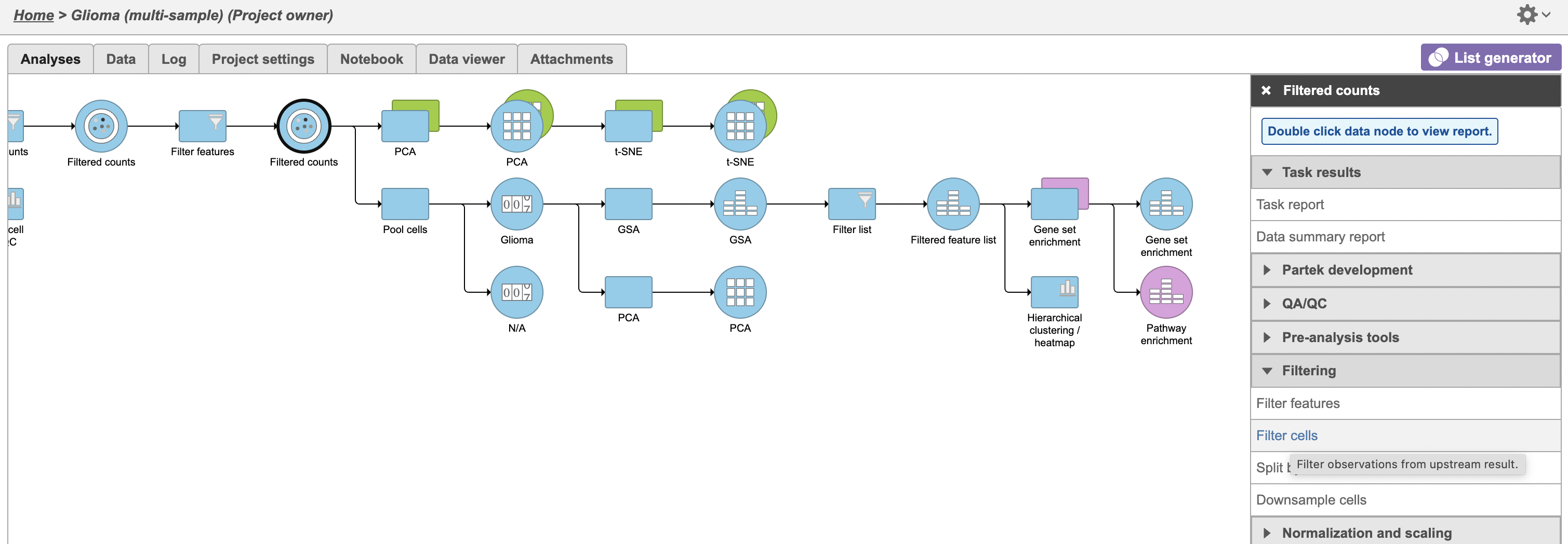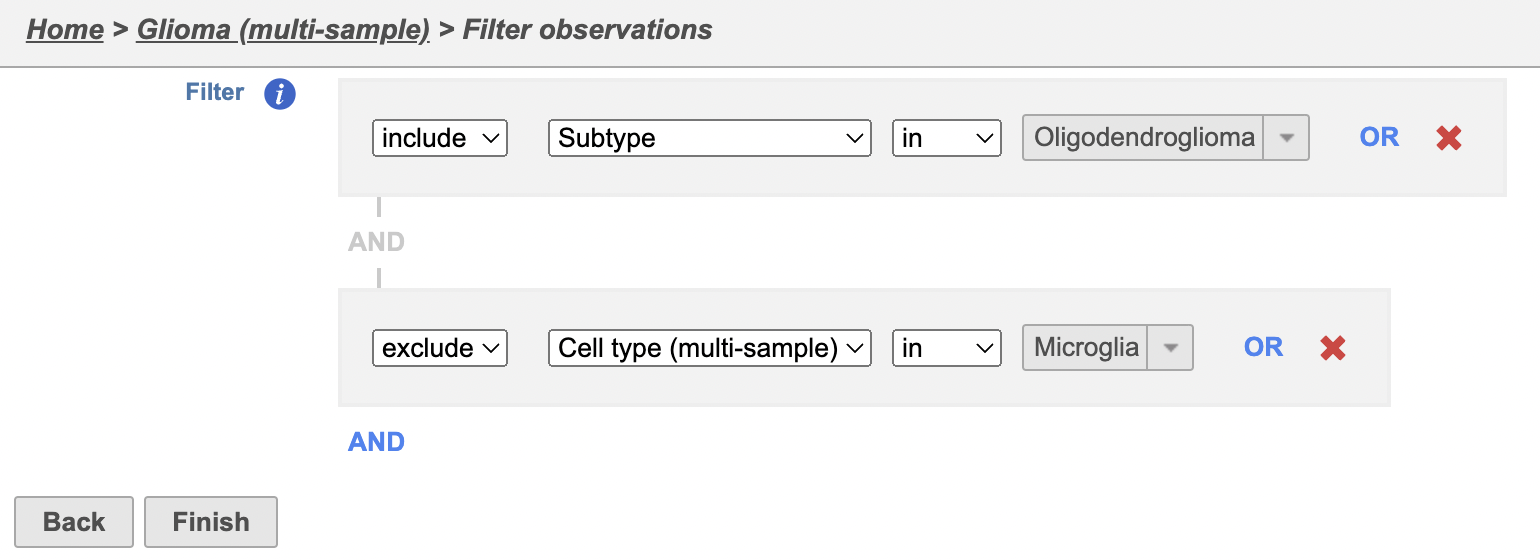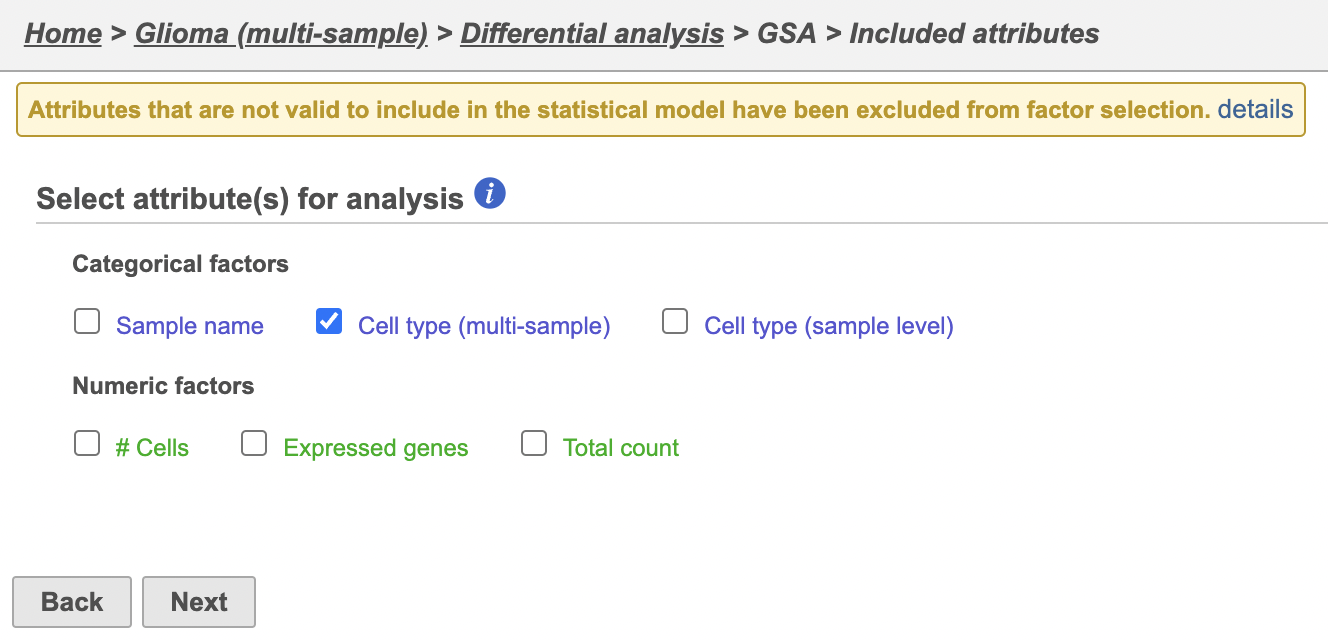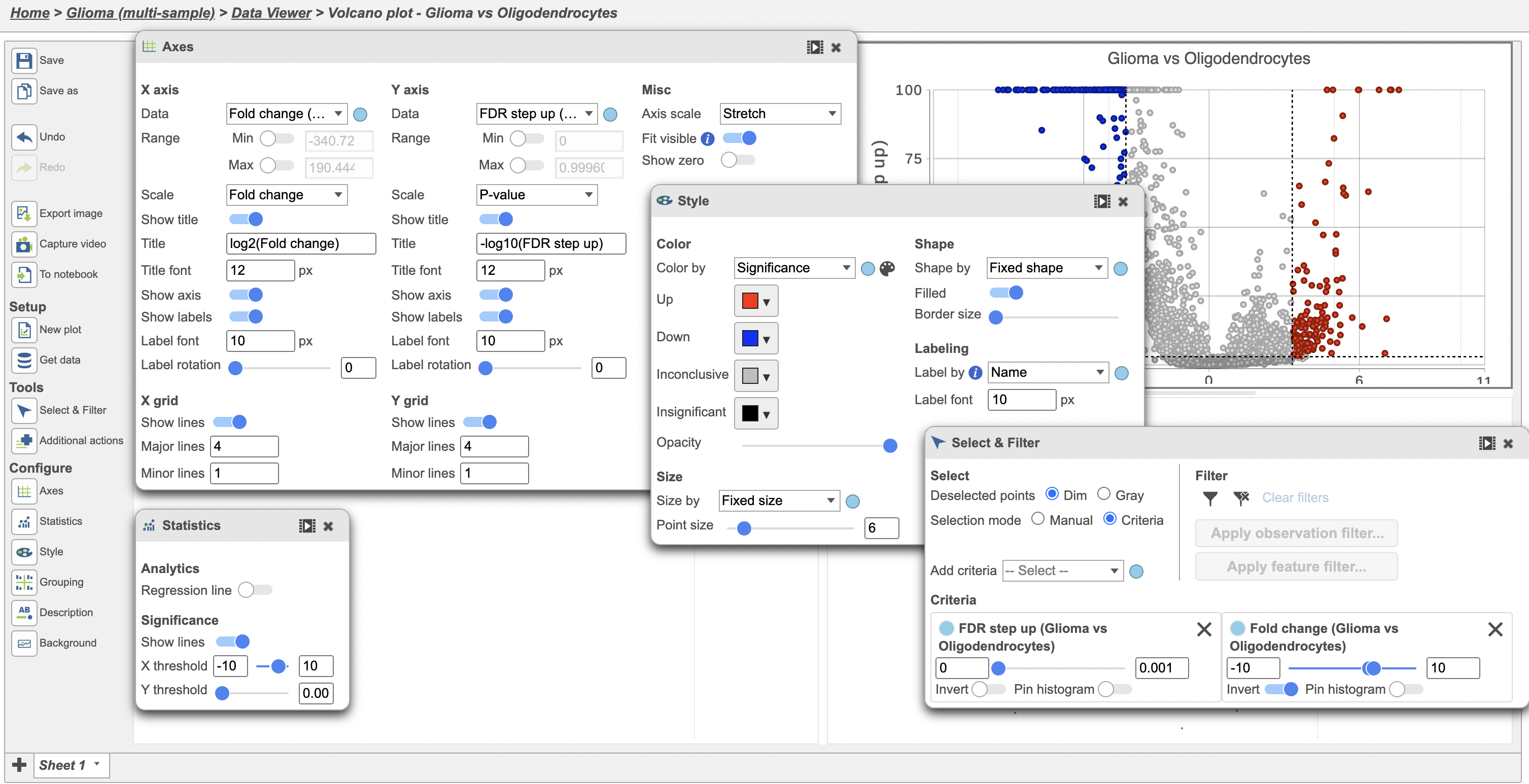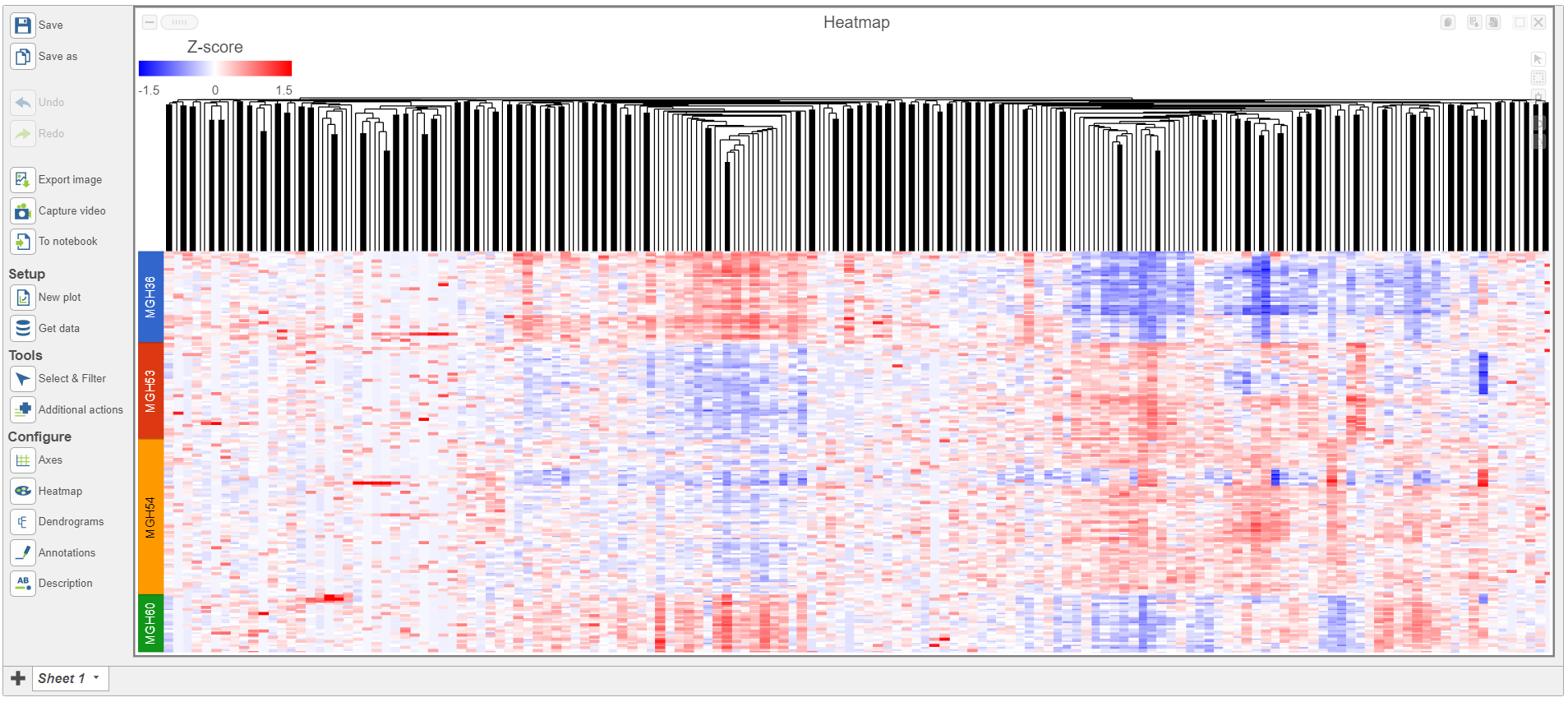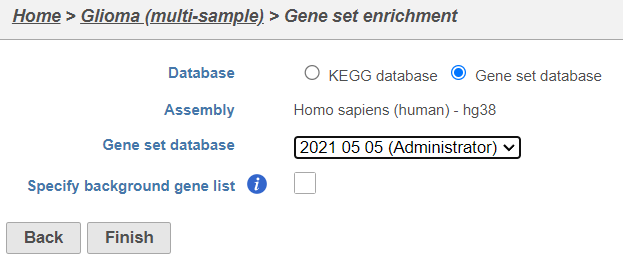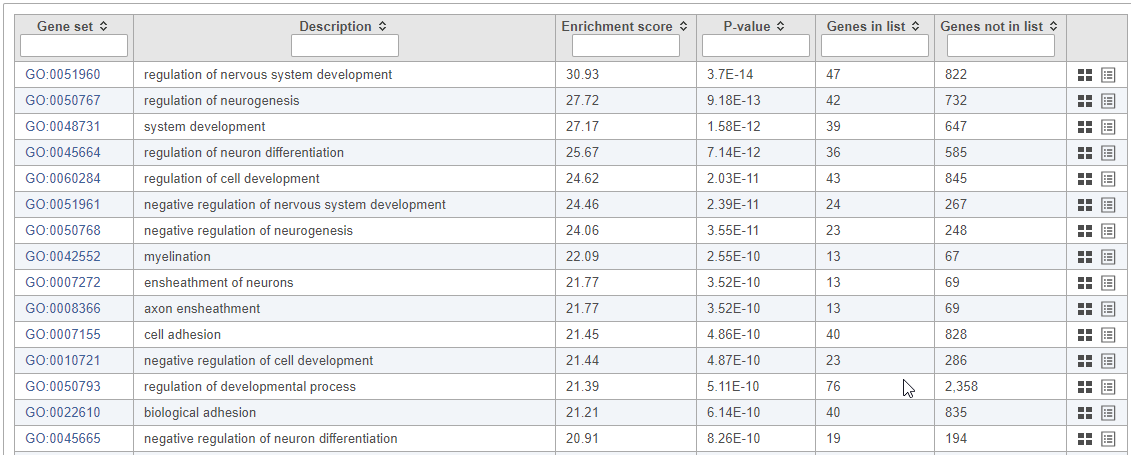Differential expression analysis can be used to compare cell types. Here, we will compare glioma and oligodendrocyte cells to identify genes differentially regulated in glioma cells from the oligodendroglioma subtype. Glioma cells in oligodendroglioma are thought to originate from oligodendrocytes, thus directly comparing the two cell types will identify genes that distinguish them.
Filter cells
To analyze only the oligodendroglioma subtype, we can filter the samples.
- Click the Filtered counts data node
- Expand Filtering in the task menu
- Click Filter cells (Figure 1)
The filter lets us include or exclude samples based on sample ID and attribute.
- Set the filter to Include samples where Subtype is Oligodendroglioma
- Click AND
- Set the second filter to exclude Cell type (multi-sample) is Microglia
- Click Finish to apply the filter (Figure 2)
Identify differentially expressed genes
- Click the new Filtered counts data node
- Click Statistics > Differential analysis in the task menu
- Click GSA
The configuration options (Figure 4) includes sample and cell-level attributes. Here, we want to compare different cell types so we will include Cell type (multi-sample).
- Click Cell type (multi-sample)
- Click Next
Next, we will set up a comparison between glioma and oligodendrocyte cells.
- Click Glioma in the top panel
- Click Oligodendrocytes in the bottom panel
- Click Add comparison (Figure 5)
This will set up fold calculations with glioma as the numerator and oligodendrocytes as the denominator.
- Click Finish to run the GSA
A green GSA data node will be generated containing the results of the GSA.
- Double-click the green GSA data node to open the GSA report
Because of the large number of cells and large differences between cell types, the p-values and FDR step up values are very low for highly significant genes. We can use the volcano plot to preview the effect of applying different significance thresholds.
- Click to view the Volcano plot
- Open the Style icon on the left, change Size point size to 6
- Open the Axes icon on the left and change the Y-axis to FDR step up (Glioma vs Oligodendrocytes)
- Open the Statistics icon and change the Significance of X threshold to -10 and 10 and the Y threshold to 0.001
- Open the Select & Filter icon, set the Fold change thresholds to -10 and 10
- In Select & Filter, click to remove the P-value (Glioma vs Oligodendrocytes) selection rule. From the drop-down list, add FDR step up (Glioma vs Oligodendrocytes) as a selection rule and set the maximum to 0.001
Note these changes in the icon settings and volcano plot below (Figure 6).
We can now recreate these conditions in the GSA report filter.
- Click GSA report tab in your web browser to return to the GSA report
- Click FDR step up
- Set the FDR step up filter to Less than or equal to 0.001
- Press Enter
- Click Fold change
- Set the Fold change filter to From -10 to 10
- Press Enter
The filter should include 291 genes.
- Click to apply the filter and generate a Filtered Feature list node
Exploring differentially expressed genes
To visualize the results, we can generate a hierarchical clustering heatmap.
- Click the Filtered feature list produced by the Differential analysis filter task
- Click Exploratory analysis in the task menu
- Click Hierarchical clustering/heatmap
Using the hierarchical clustering options we can choose to include only cells from certain samples. We can also choose the order of cells on the heatmap instead of clustering. Here, we will include only glioma cells and order the samples by sample name (Figure 7).
- Make sure Cluster is unchecked for Cell order
- Click Filter cells under Filtering and set the filter to include Cell type (multi-sample) is Glioma
- Choose Sample name from the Cell order drop-down menu in the Assign order section
- Click Finish
- Double click the green Hierarchical clustering node to open the heatmap
The heatmap differences may be hard to distinguish at first; the range from red to blue with a white midpoint is set very wide because of a few outlier cells. We can adjust the range to make more subtle differences visible. We can also adjust the color.
- Set the Range toggle Min to -1.5
- Set the Range toggle Max to 1.5
The heatmap now shows clear patterns of red and blue.
- Click Axis titles and deselect the Row labels and Column labels of the panel to hide sample and feature names, respectively.
- Select Sample name from the Annotations drop-down menu
Cells are now labeled with their sample name. Interestingly, samples show characteristic patterns of expression for these genes (Figure 8).
- Click Glioma (multi-sample) to return to the Analyses tab.
We can use gene set enrichment to further characterize the differences between glioma and oligodendrocyte cells.
- Click the Filtered feature list node
- Click Biological interpretation in the task menu
- Click Gene set enrichment
- Change Database to Gene set database and click Finish to continue with the most recent gene set (Figure 9)
A Gene set enrichment node will be added to the pipeline .
- Double-click the Gene set enrichment task node to open the task report
Top GO terms in the enrichment report include "ensheathment of neurons" and "axon ensheathment" (Figure 10), which corresponds well with the role of oligodendrocytes in creating the myelin sheath that supports and protect axons in the central nervous system.
Additional Assistance
If you need additional assistance, please visit our support page to submit a help ticket or find phone numbers for regional support.


| Your Rating: |
    
|
Results: |
    
|
31 | rates |
